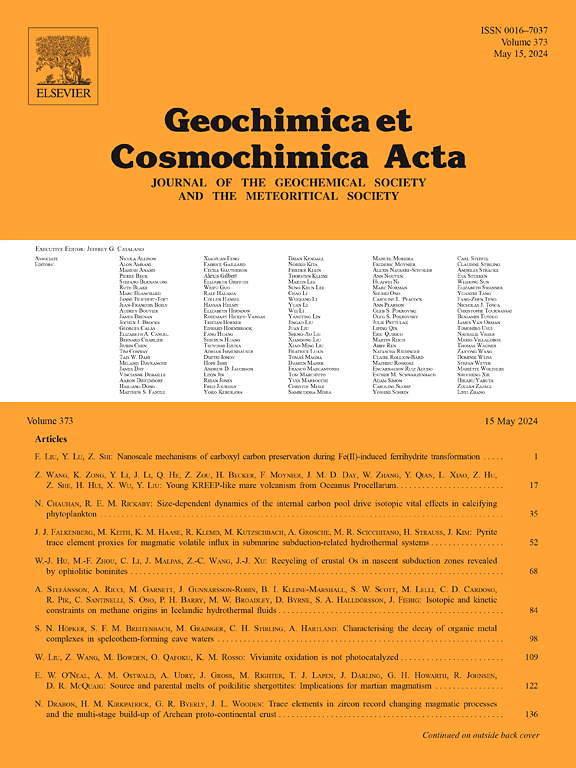火成岩锆石中铀钍分配的温度依赖性
IF 4.5
1区 地球科学
Q1 GEOCHEMISTRY & GEOPHYSICS
引用次数: 0
摘要
锆石具有化学和物理上的耐久性,并易于掺入铀、钍等放射性微量元素,是地质年代学中的重要矿物。定量划分锕系元素对于限定锆石中230Th的初始非长期平衡量至关重要。在长期平衡条件下,这种初始的230的过剩/不足将产生206Pb的过剩或不足,从而影响206Pb/238U年龄的计算(Schärer, 1984, Mattinson, 1973)。然而,在对年轻火成岩锆石进行年龄校正时,没有标准的方法来计算Th/U分配比,这使得不确定性难以估计。为了更好地理解作为长期不平衡校正基石的锆石/熔体的U和Th分配,在单大气实验中,以玄武岩安山岩、安山岩和流纹岩为原料,掺杂Zr、U和Th合成了锆石。考察了不同的实验温度和氧逸度条件(ΔQFM−4 ~ ΔQFM+4)对U和Th分配的影响。此外,我们还具体量化了扇形分区、分级结晶和熔体成分对U和Th分配的影响。结合实验和天然锆石数据,我们发现温度对锆石中U和Th的分配起主要控制作用,并校准了这些分配系数与结晶温度之间的反比关系。当锆石结晶温度已知时,校正方程可应用于230次校正,以提高th校正的206Pb/238U年代的精度。本文章由计算机程序翻译,如有差异,请以英文原文为准。
Temperature dependence of uranium and thorium partitioning in igneous zircons
Zircon is a key mineral in geochronology because of its chemical and physical durability and tendency to incorporate radioactive trace elements such as U and Th. Quantifying the partitioning of the actinide elements is critical to constrain initial non-secular equilibrium amounts of 230Th in zircon. An excess or deficit of 206Pb will be produced from such an initial excess/deficit of 230Th from the secular equilibrium condition, which influences the calculated 206Pb/238U age (Schärer, 1984, Mattinson, 1973). However, there is no standard way to calculate Th/U partitioning ratios when applying age corrections to young igneous zircon, making uncertainties hard to estimate. To better understand U and Th partitioning of zircon/melt that is the cornerstone of the secular disequilibrium correction, zircon was synthesized in one-atmosphere experiments using basaltic andesite, andesite, and rhyolite starting materials, doped with Zr, U, and Th. Different experimental temperatures and oxygen fugacity conditions (ΔQFM−4 to ΔQFM+4) were explored to examine their effects on U and Th partitioning. In addition, we specifically quantify the effects of sector zoning, fractional crystallization, and melt composition on U and Th partitioning. By combining experimental and natural zircon data, we find that temperature has the primary control on the partitioning of U and Th in the zircon and calibrate an inverse relationship between these partition coefficients and crystallization temperatures. The calibrated equation can be applied to the 230Th correction for an improvement in the accuracy of Th-corrected 206Pb/238U dates when the zircon crystallization temperature is known.
求助全文
通过发布文献求助,成功后即可免费获取论文全文。
去求助
来源期刊

Geochimica et Cosmochimica Acta
地学-地球化学与地球物理
CiteScore
9.60
自引率
14.00%
发文量
437
审稿时长
6 months
期刊介绍:
Geochimica et Cosmochimica Acta publishes research papers in a wide range of subjects in terrestrial geochemistry, meteoritics, and planetary geochemistry. The scope of the journal includes:
1). Physical chemistry of gases, aqueous solutions, glasses, and crystalline solids
2). Igneous and metamorphic petrology
3). Chemical processes in the atmosphere, hydrosphere, biosphere, and lithosphere of the Earth
4). Organic geochemistry
5). Isotope geochemistry
6). Meteoritics and meteorite impacts
7). Lunar science; and
8). Planetary geochemistry.
 求助内容:
求助内容: 应助结果提醒方式:
应助结果提醒方式:


